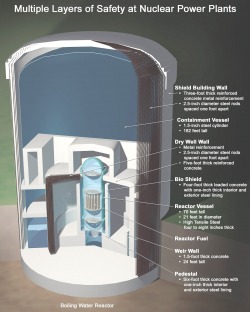About Nuclear Power
In a Nuclear power plant there are several pieces. The cooling tower, the containment vessel, turbine, and generator. The main part of the nuclear power plant is the containment vessel. In there, uranium fuel rods (a bunch of uranium pellets) are lowered into the reactor vessel. The workers release a neutron into the uranium. When the neutron hits a uranium atom, the atom splits. Two more neutrons are released. That is called nuclear fission. When more uranium atoms are hit, and more neutrons are released that is called a chain reaction. One uranium pellet about the size of your pinkie finger produces about as much energy as 2,000 coal pellets. Or 1,000 kilograms of burning coal. This produces massive heat turning the water in pipes around the containment vessel into steam. The steam is directed to the turbines where the steam is used to spin the turbine. The turbine spins the generator producing energy. The water/steam is directed to the cooling towers, which are the big towers with holes at the top. The water/steam goes into the condenser cooling down the steam turning it into water. Pipes lead from the condenser to the containment vessel… Making the whole cycle start again. Nuclear power doesn’t pollute the air. The only thing that might go into the air is steam. The steam comes from the cooling towers, but most people mistake that steam for smoke. Nuclear power also has a bad side. For instance it’s hard trying to find a place to keep radioactive waste for thousands of years without harming people. Not to mention the whole nuclear power plant can still cause a meltdown. Almost kind of like a nuclear bomb. But still, Nuclear power is an environment safe energy plant.

